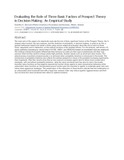| dc.contributor.author | Zervoudi, Evanthia K. | |
| dc.date.accessioned | 2021-09-06T13:17:54Z | |
| dc.date.available | 2021-09-06T13:17:54Z | |
| dc.date.issued | 2017 | |
| dc.identifier.issn | 2160-9802 | |
| dc.identifier.uri | http://hdl.handle.net/11728/12015 | |
| dc.description.abstract | The main aim of this paper is to empirically evaluate the role of three significant factors of the Prospect Theory: the S-shaped value function, the loss aversion, and the distortion of probability, in decision making. In order to do this, a general behavioral reward-risk model is firstly setup and an empirical evaluation about the role of each of these factor, separately and in interaction, on the optimal solutions of the problem follows. For the analysis, well known US equity portfolios consisting by stocks listed in NYSE, AMEX, and NASDAQ formed on investment style are employed. The findings indicate that agents differentiate their behavior according to their type of preferences and their loss aversion level but they seem to always prefer high positively skewed assets such as small and value stocks. The attractiveness of positively skewed assets is re-enforced when probability distortion is introduced in the model. The introduction of probability distortion also affects the optimal perspective values of the problem increasing significantly their magnitude. After that, results show that as loss aversion increases agents tend to follow more conservative strategies, with and without probability distortion, while the value functional form has also its role in the model; bounded value functions as the negative exponential function drives agents to more conservative behaviors while unbounded value functions as the piecewise power function give the incentive to agents to undertake great risks and follow more aggressive strategies. The examination of the interaction of these factors indicate that the combination of an unbounded value functional form with a large loss aversion index may reduce agents' aggressiveness and limit (but not alter) the value functional form effect on optimal solutions. | en_UK |
| dc.language.iso | en | en_UK |
| dc.publisher | IGI Publications | en_UK |
| dc.relation.ispartofseries | International Journal of Applied Behavioral Economics (IJABE);vol.6, no.2, 2017: pp.1-22. | |
| dc.rights | © 2017 | en_UK |
| dc.rights.uri | http://creativecommons.org/licenses/by-nc-nd/4.0/ | en_UK |
| dc.subject | Research Subject Categories::SOCIAL SCIENCES::Business and economics | en_UK |
| dc.subject | Prospect Theory | en_UK |
| dc.subject | decision making | en_UK |
| dc.subject | S-shaped value function | en_UK |
| dc.subject | probability distortion. | en_UK |
| dc.title | Evaluating the Role of Three Basic Factors of Prospect Theory in Decision Making: An Empirical Study | en_UK |
| dc.type | Article | en_UK |
| dc.doi | 10.4018/IJABE.2017040101 | en_UK |


